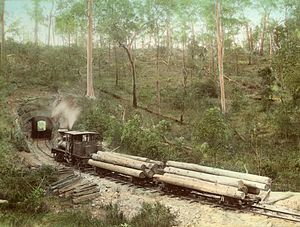Canungra Pine Creek Tramway
| Canungra Pine Creek Tramway | |||||||||||||||||||||||||||||||||||||||||||||
|---|---|---|---|---|---|---|---|---|---|---|---|---|---|---|---|---|---|---|---|---|---|---|---|---|---|---|---|---|---|---|---|---|---|---|---|---|---|---|---|---|---|---|---|---|---|
|
tunnel
| |||||||||||||||||||||||||||||||||||||||||||||
| Route length: | 26.6 km | ||||||||||||||||||||||||||||||||||||||||||||
| Gauge : | 1067 mm ( cape track ) | ||||||||||||||||||||||||||||||||||||||||||||
|
|||||||||||||||||||||||||||||||||||||||||||||
The Canungra Pine Creek Tramway was a 16.6 mile long private Cape - gauge forest railway at Canungra in Queensland , Australia . It was in operation from 1903 to 1933.
location
With the forest railway with a gauge of 1067 mm (3 feet 6 inches ) long timber was brought from the wooded areas in Pine Creek Valley to the sawmill of the Lahey family in Canungra and from there from 1915 lumber to Canungra station.
history
construction
The Lahey family founded a sawmill in Canungra in 1884. At the end of the 1880s, she held the rights to 16,000 hectares of wood lease and pulled tree trunks from her forest to the sawmill with ox carts. The family decided to build a forest railway into the Pine Creek Valley. The 3 foot 6 inch gauge was chosen to be the same gauge as the Queensland Government Railways to avoid time consuming reloading. The railway engineer George Phillips measured and designed the route.
A tunnel was drilled at the apex of the route to avoid a long detour. It was built from January 1, 1901 and was first used in September 1903. The route was extended to a total of 26.6 kilometers in the following ten years. From 1915 there was a connection to the state railway line from Logan Village to Canungra . When the demand for wood subsided, the line was still used for excursions, but sold and dismantled in 1933.
During the Second World War, the tunnel was used to store ammunition for the Kokoda barracks in Canungra. Although the listed tunnel was reopened to pedestrians in 2001, safety concerns have meanwhile led to the tunnel being closed, but the tunnel portals are still accessible.
Locomotives
The first steam locomotive, a Climax geared locomotive , was procured in 1903.
A factory number 697 Shay geared locomotive was originally delivered in 1902 from Lima , Ohio to the Mount Lyell Mining and Railway Company in Tasmania , where it received its number 5. It was bought second-hand by the Laheys around 1906 and had the serial number 697. It weighed 16 tons and had a nine-inch bore and an eight-inch stroke. The wheels were 27 inches in diameter. The locomotive was equipped with a bell and a large oil headlight. The locomotive was operated with cordwood and deadwood. In 1915 it was converted to coal firing.
A second shay was bought new in 1910. The Climax locomotive was taken out of service in 1912, but was overhauled by Walkers of Maryborough in 1914 and used until 1922. Laheys ordered a third Shay locomotive in 1911, but it was sold to the Hampton Cloncurry Mines in 1912 without having previously been used on the forest railway.
On the route also a converted as a rail vehicle were Ford Model T and a converted as shunting Commer - trucks used.
Matthew Nathan visits the forest railway, 1922
Cable car cabin with lock and chain
Individual evidence
- ^ John Kerr: Tall Timber and Tramlines Queensland. Retrieved August 10, 2018.
- ↑ a b c Lahey's Canungra Tramway Tunnel. Darlington Range Road, Canungra. 2009 (CC BY 4.0). Retrieved August 9, 2018.
- ↑ Shay Locomotive 5, part of the Canungra Pine Creek Tramway, ca.1914. Retrieved August 10, 2018.
Coordinates: 28 ° 1 ′ 23.1 ″ S , 153 ° 10 ′ 18.6 ″ E






